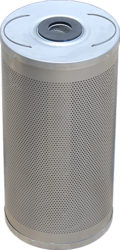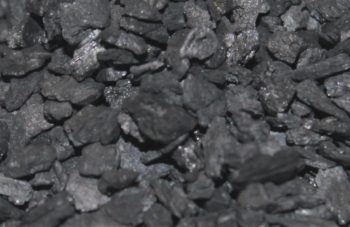For Winston/Royal Guard Type 61V-C Activated Carbon Filters


Amine filtration and glycol filtration: The WCFL-1122 series activated carbon canisters with activated virgin carbon are furnished in the Type 61V-C Activated Carbon Filter to remove dissolved hydrocarbons and other impurities from amine and glycol processes for the prevention of foaming and reduction of corrosion. The impurities are removed as they come into contact with the activated carbon and are adsorbed onto the exterior and interior porous surfaces of the carbon particles. The “activated” carbon has been processed typically by exposure to high temperature steam to open pores in each carbon granule creating many times the original surface area. The impurities do not “absorb”, or assimilate into the carbon, but rather they “adsorb”, or accumulate on the carbon’s external surfaces.
The galvanized steel activated carbon canister has a perforated exterior housing and interior core allowing for a radial flow through the carbon media. The flow exits through a 2” diameter opening in the bottom of the canister. Heavy wire lifting handles are provided in the top of the canister which can be folded flat after installation into the filter vessel. To aid in retention of the carbon media, a cotton bag is placed into the canister prior to filling. The canisters may be stacked two or three high. Vertical flow canisters are also available.
Operating Specifications:
- Recommended flow rate: 1.5 GPM per canister.
- Radial flow is outside to inside.
- Recommended maximum operating temperature is 150⁰ F. for best retention of impurities. Higher temperatures may provide less retention.
- Gaskets are Buna-N for temperatures up to 250⁰ F.
- Activated carbon canisters should not develop a significant increase in differential pressure during use when provided with proper upstream particulate filtration.
Activated Carbon:
- Carbon: activated virgin carbon
- Type: coal
- Mesh size of carbon: 8 x 30
- Molasses number: 400 (typ.)
- Iodine number: 1000 mg/g (min.)
- Ash, total: 12%
Activated Carbon Canisters:
- Canister: galvanized steel
- Gaskets: Buna-N
- Liner: cotton
- Dimensions of canister: 11” diameter x 22” tall (nom.)
- Interior core diameter: 2”
Mesh size refers to a measurement of the activated carbon granule. In this case, 85% of the granules will fall through an 8 × 8 US wire mesh sieve and 95% will be retained on a 30 × 30 US wire mesh sieve placed below.
Molasses number is derived from the decolorization from molasses in solution, and refers to the measure of the content of mesopores (pores having diameters 2–50 nm) in the carbon granule after it has been activated compared to a standard carbon granule. The higher the number, the larger the molecule captured.
Iodine number is based on the amount of iodine adsorbed in testing, and is an indicator as to the porosity, or the content of micropores (pores having diameters ≤ 2 nm) in the carbon granule after it has been activated. The higher the number, the more activation in the carbon particle.
Ash is the measurement of oxides in the activated carbon granule expressed as a percentage. The lower the percentage, the higher the carbon portion of the granule and its activity.
